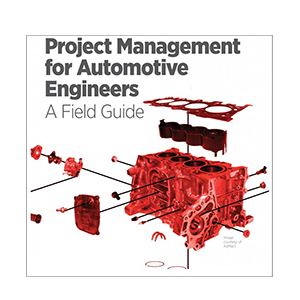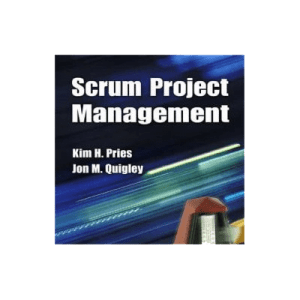Book Summary
Project Management for Automotive Engineers: A Field Guide was developed to help automotive engineers be better project managers by anticipating changes and responding swiftly to them. The book teaches the reader how to be watchful for triggers that adversely impact the expected outcomes of the projects with which they are involved.
Providing practical examples, this title is based on the authors’ solid experience managing projects of various degrees of complexity in the ground vehicle industry. Automotive projects involve many suppliers dispersed across the globe, and can often span multiple years. Project scope change is not uncommon, and so too the budget constraints and tight deadlines. This book serves as an excellent guide on how to manage continuous change.
Project Management for Automotive Engineers: A Field Guide serves as a reference for a practicing project manager, explaining critical concepts with examples rooted in the challenges of the automotive field with its engineering, product logistics, and leadership complexity.
Book Reviews
This is a much-needed book. Back in 2002, I was on a team working on an Automotive Extension to the PMBOK® Guide. There was a lot of value there with some issues. The leader of the effort was not a PMP and did not know the PMBOK® well, which brought challenges. I started having concerns that is was turning into a public publication of many of Delphi’s processes without as much from the other companies. We had it about 75% done. The leader got busy with other interests and PMI pulled the plug.
I’m glad to see that you are doing this with SAE in a good way.
– Fred Koos, PE, PMP, CSM, CSPO President, Pittsburgh PMI 1/24/2016
Very valuable for automotive engineers. The book provides basic guidelines to run the project management activity and background information why relevant processes have been established. I like the document.
– Dr. Wolfgang Zientz Managing Director: DEINE – Deutsche Ingenieure GmbH, Germany 3/18/2016
“Project Management for Automotive Engineers” turns out to be an enterprise-wide look at project management in the automotive and heavy truck industries. Only those in the upper executive levels will have clear visibility into all that is described here, much less the opportunity to pull all of the levers. Still, you get a good idea of what should be happening, and why. In their book “Built to Last – Successful Habits of Visionary Companies,” Collins and Porras point out that even if you find yourself in a less than visionary company, there is still advantage to carving out the ideals in your own small corner. “Project Management…” gives you plenty of good suggestions to start carving.
Working engineers will find different parts of the book familiar, depending on where you’ve spent your time. For me, the early chapters bring to mind GM’s Vehicle Line Engineers, as described by Bob Lutz, in his “Bean Counters…” book. Or rather, it leaves you wishing GM’s VLEs had read Quigley’s book!
Jon has endured plenty of the internal political intrigue, common to old-line automotive development culture. His books usually reflect this in the form of “war stories” and fairly direct guidance on navigating typical pitfalls. In “Project Management…” he has dialed things back a bit. Perhaps this is a matter of audience. Writing for SAE is no doubt a more politically correct endeavor than writing for independent tech publishers. A friend once divided Billy Joel’s music into earlier and later work, or as he put it, Billy-before-he-died and Billy-after. Quigley’s edgy style may be on life support in this book. That would be a shame, considering the excellent advice peppered throughout his earlier works. Co-author Roopa Shenoy brings not only the firebrand of youth, but of a young branch of the industry. Her insight and expression help broaden accessibility of the material. Expect to see her marks, in both industry and print.
The mid-chapters better reflect my experience. Thus it feels like they are delivering more actionable content. The early chapters were more cautionary material, more things I wish others were paying attention to. Chapter 8 veers back toward the early chapters, but leaves me wanting a checklist of the great considerations offered. The summary chapters are good, but I’d like to see a “master checklist” as an appendix to the second edition.
At the very least, every OEM and Tier 1 new hire should read this book. Automotive development has grown far too complex to dive in without an objective road map. If you are in the three-to-five-year category, chances are you’re beginning to grasp much of this on your own – the hard way. When you find yourself shaking your head, saying WTF!, this book is a good place to look for your sanity. For the well experienced it is a good reminder of what you should be about.
Quigley and company have several good topical books in the marketplace. I suggest looking them up.
– Fred Starkey Vice President Product Development RightPSI, Inc. 3/31/2016
Now that I finished the book completely. I felt this,
1. The overview at the initial chapter is very good.
2. The most loved part is chapter 6, 7, 8, ,9.
3. The book covers the experience of a automotive production. I felt like I am actually making a car for a big automotive company which is brilliant.
I wanted some more industrial knowledge management and change management works. With few live examples of you knew any. The book closure is expected one which most of the PM books cover. I was expecting something beyond the traditional PM methods at that point.
Your views on verification and validation is very good. The need for testing is actually highlighted and the methods explained are really interesting, but could’ve added few more testing methodologies I felt.
Totally in a nutshell the book is just amazing and pragmatic which is great. I felt I don’t know much of the game and I wish I can learn few things from you at Value Transformation LLC around July. At my summer break. I am very impressed by your enthusiasm and eagerness at this age. Keep the good work. Many of my friends need this copy to read and they have ordered at Chalmers library. Hope they would buy a soft copy or hard copy and give it to them.
– Shreyas Dwarakanath 05/01/2017
Project Management for Automotive Engineers: A Field Guide – By Jon M. Quigley and Roopa J. Shenoy
This is a book which has been designed with a view to describe the principles of project management within the context of the automobile industry. From start to finish, from basic planning to merging the entire range of thinking processes, the book formulates a working plan in application in order to guide and control the sum of all activities through the implementation of the project.
Essentially the book is broken down into a description of the several fundamental steps that when placed together in sequence, will generate the complete blueprint for the methodical execution of the project in pursuit of the final goal of project delivery.
The book is divided into the following sections –
-Overview of Managing Automotive Projects
-Business Case and Product Development Models
-Vehicle Subsystem and Concept Generation
-Product Development
-Process Development
-Product Life Cycle and Testing
-Design to Ramp Up Production
-Early Production
-Project Closure and Something More
-Closing Remarks
Lucidly and methodically written from a depth of industrial experience and academic observation, the book enables the reader to grasp the core tenets of project development with the application of knowledge and research and all the ideas and concepts to take a design from the drawing board to the completed physical product for the consumer market. The book fairly balances practical design assumptions within the parameters of risk and cost assessments. Stage by stage the project activities are described in great detail with a view of achieving the project requirements through the cycle of project development for an Automotive Project.
The skillful presentation of the book maybe used as a reference guide for other industries and concepts besides the Automobile Industry for essentially the book represents the quintessential description on how ideas can be organized and fashioned to the final creation of a product or service that may satisfy the consumer need.
– Bruno Bernard 8/14/2017
Project Management for Automotive Engineers: A Field Guide – By Jon M. Quigley and Roopa J. Shenoy
I am delighted by simplicity of your book and how it use no necessary jargon that distinguish engineers and feasibility experts and find it amuzing with plenty of examples of real life projects consulted my buddy mechanical engineer on combust engines for technical explanation
– https://twitter.com/AlexRankovic 2/21/2018
Just finished THE book. It has been a delicious meal for my mind. As someone who has been working at a car factory in EOL implementing the computer assisted tests for the last 2 years, imagine how much you have expanded and enriched my global view of all the process. I will keep your book really close while I keep studying and working everyday aiming to become a PM in the future once my knowledge and experience fulfill the needs of such a position.
I will post a review this week in Amazon and goodreads and send you the link, but I wanted to thank you for the book again first. Seriously, it has changed my point of view critically, and now I am starting to understand a lot better the complete process and how every piece of the puzzle should be evaluated and considered before, during and after a project decision is taken.
I’m used to see just the final part of the process and your book has enlightened me for good.
Thank you for imprinting your vast knowledge and experience in such a deep and clear book, Jon. I’m really glad I asked for it.
Asar @DonPopotamo 7/21/2020





